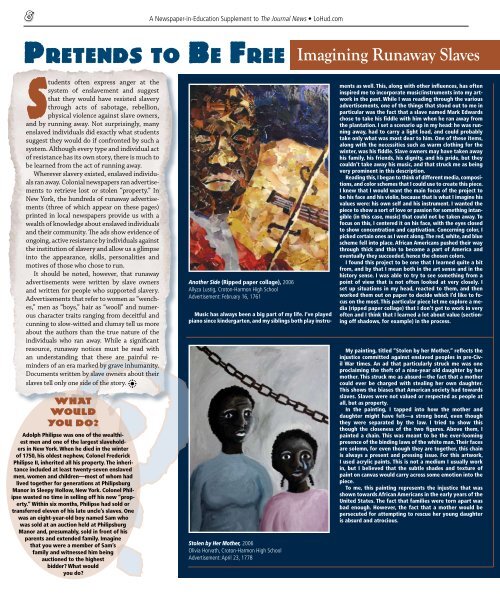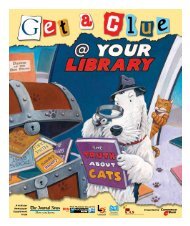Slavery in the Lower Hudson Valley - The Journal News
Slavery in the Lower Hudson Valley - The Journal News
Slavery in the Lower Hudson Valley - The Journal News
Create successful ePaper yourself
Turn your PDF publications into a flip-book with our unique Google optimized e-Paper software.
A <strong>News</strong>paper-<strong>in</strong>-Education Supplement to <strong>The</strong> <strong>Journal</strong> <strong>News</strong> • LoHud.com<br />
Pretends to Be Free Imag<strong>in</strong><strong>in</strong>g Runaway Slaves<br />
Students often express anger at <strong>the</strong><br />
system of enslavement and suggest<br />
that <strong>the</strong>y would have resisted slavery<br />
through acts of sabotage, rebellion,<br />
physical violence aga<strong>in</strong>st slave owners,<br />
and by runn<strong>in</strong>g away. Not surpris<strong>in</strong>gly, many<br />
enslaved <strong>in</strong>dividuals did exactly what students<br />
suggest <strong>the</strong>y would do if confronted by such a<br />
system. Although every type and <strong>in</strong>dividual act<br />
of resistance has its own story, <strong>the</strong>re is much to<br />
be learned from <strong>the</strong> act of runn<strong>in</strong>g away.<br />
Wherever slavery existed, enslaved <strong>in</strong>dividuals<br />
ran away. Colonial newspapers ran advertisements<br />
to retrieve lost or stolen “property.” In<br />
New York, <strong>the</strong> hundreds of runaway advertisements<br />
(three of which appear on <strong>the</strong>se pages)<br />
pr<strong>in</strong>ted <strong>in</strong> local newspapers provide us with a<br />
wealth of knowledge about enslaved <strong>in</strong>dividuals<br />
and <strong>the</strong>ir community. <strong>The</strong> ads show evidence of<br />
ongo<strong>in</strong>g, active resistance by <strong>in</strong>dividuals aga<strong>in</strong>st<br />
<strong>the</strong> <strong>in</strong>stitution of slavery and allow us a glimpse<br />
<strong>in</strong>to <strong>the</strong> appearance, skills, personalities and<br />
motives of those who chose to run.<br />
It should be noted, however, that runaway<br />
advertisements were written by slave owners<br />
and written for people who supported slavery.<br />
Advertisements that refer to women as “wenches,”<br />
men as “boys,” hair as “wooll” and numerous<br />
character traits rang<strong>in</strong>g from deceitful and<br />
cunn<strong>in</strong>g to slow-witted and clumsy tell us more<br />
about <strong>the</strong> authors than <strong>the</strong> true nature of <strong>the</strong><br />
<strong>in</strong>dividuals who ran away. While a significant<br />
resource, runaway notices must be read with<br />
an understand<strong>in</strong>g that <strong>the</strong>se are pa<strong>in</strong>ful rem<strong>in</strong>ders<br />
of an era marked by grave <strong>in</strong>humanity.<br />
Documents written by slave owners about <strong>the</strong>ir<br />
slaves tell only one side of <strong>the</strong> story. b<br />
WHAT<br />
WOULD<br />
YOU DO?<br />
Adolph Philipse was one of <strong>the</strong> wealthiest<br />
men and one of <strong>the</strong> largest slaveholders<br />
<strong>in</strong> New York. When he died <strong>in</strong> <strong>the</strong> w<strong>in</strong>ter<br />
of 1750, his oldest nephew, Colonel Frederick<br />
Philipse II, <strong>in</strong>herited all his property. <strong>The</strong> <strong>in</strong>heritance<br />
<strong>in</strong>cluded at least twenty-seven enslaved<br />
men, women and children—most of whom had<br />
lived toge<strong>the</strong>r for generations at Philipsburg<br />
Manor <strong>in</strong> Sleepy Hollow, New York. Colonel Philipse<br />
wasted no time <strong>in</strong> sell<strong>in</strong>g off his new “property.”<br />
With<strong>in</strong> six months, Philipse had sold or<br />
transferred eleven of his late uncle’s slaves. One<br />
was an eight-year-old boy named Sam who<br />
was sold at an auction held at Philipsburg<br />
Manor and, presumably, sold <strong>in</strong> front of his<br />
parents and extended family. Imag<strong>in</strong>e<br />
that you were a member of Sam’s<br />
family and witnessed him be<strong>in</strong>g<br />
auctioned to <strong>the</strong> highest<br />
bidder? What would<br />
you do?<br />
Ano<strong>the</strong>r Side (Ripped paper collage), 2006<br />
Allyza Lustig, Croton-Harmon High School<br />
Advertisement: February 16, 1761<br />
Stolen by Her Mo<strong>the</strong>r, 2006<br />
Olivia Horvath, Croton-Harmon High School<br />
Advertisement: April 23, 1778<br />
Music has always been a big part of my life. I’ve played<br />
piano s<strong>in</strong>ce k<strong>in</strong>dergarten, and my sibl<strong>in</strong>gs both play <strong>in</strong>struments<br />
as well. This, along with o<strong>the</strong>r <strong>in</strong>fluences, has often<br />
<strong>in</strong>spired me to <strong>in</strong>corporate music/<strong>in</strong>struments <strong>in</strong>to my artwork<br />
<strong>in</strong> <strong>the</strong> past. While I was read<strong>in</strong>g through <strong>the</strong> various<br />
advertisements, one of <strong>the</strong> th<strong>in</strong>gs that stood out to me <strong>in</strong><br />
particular was <strong>the</strong> fact that a slave named Mark Edwards<br />
chose to take his fiddle with him when he ran away from<br />
<strong>the</strong> plantation. I set a scenario up <strong>in</strong> my head: he was runn<strong>in</strong>g<br />
away, had to carry a light load, and could probably<br />
take only what was most dear to him. One of <strong>the</strong>se items,<br />
along with <strong>the</strong> necessities such as warm cloth<strong>in</strong>g for <strong>the</strong><br />
w<strong>in</strong>ter, was his fiddle. Slave owners may have taken away<br />
his family, his friends, his dignity, and his pride, but <strong>the</strong>y<br />
couldn’t take away his music, and that struck me as be<strong>in</strong>g<br />
very prom<strong>in</strong>ent <strong>in</strong> this description.<br />
Read<strong>in</strong>g this, I began to th<strong>in</strong>k of different media, compositions,<br />
and color schemes that I could use to create this piece.<br />
I knew that I would want <strong>the</strong> ma<strong>in</strong> focus of <strong>the</strong> project to<br />
be his face and his viol<strong>in</strong>, because that is what I imag<strong>in</strong>e his<br />
values were: his own self and his <strong>in</strong>strument. I wanted <strong>the</strong><br />
piece to show a sort of love or passion for someth<strong>in</strong>g <strong>in</strong>tangible<br />
(<strong>in</strong> this case, music) that could not be taken away. To<br />
focus on this, I centered it on his face, with <strong>the</strong> eyes closed<br />
to show concentration and captivation. Concern<strong>in</strong>g color, I<br />
picked certa<strong>in</strong> ones as I went along. <strong>The</strong> red, white, and blue<br />
scheme fell <strong>in</strong>to place. African Americans pushed <strong>the</strong>ir way<br />
through thick and th<strong>in</strong> to become a part of America and<br />
eventually <strong>the</strong>y succeeded, hence <strong>the</strong> chosen colors.<br />
I found this project to be one that I learned quite a bit<br />
from, and by that I mean both <strong>in</strong> <strong>the</strong> art sense and <strong>in</strong> <strong>the</strong><br />
history sense. I was able to try to see someth<strong>in</strong>g from a<br />
po<strong>in</strong>t of view that is not often looked at very closely. I<br />
set up situations <strong>in</strong> my head, reacted to <strong>the</strong>m, and <strong>the</strong>n<br />
worked <strong>the</strong>m out on paper to decide which I’d like to focus<br />
on <strong>the</strong> most. This particular piece let me explore a media<br />
(ripped paper collage) that I don’t get to work <strong>in</strong> very<br />
often and I th<strong>in</strong>k that I learned a lot about value (section<strong>in</strong>g<br />
off shadows, for example) <strong>in</strong> <strong>the</strong> process.<br />
My pa<strong>in</strong>t<strong>in</strong>g, titled “Stolen by her Mo<strong>the</strong>r,” reflects <strong>the</strong><br />
<strong>in</strong>justice committed aga<strong>in</strong>st enslaved peoples <strong>in</strong> pre-Civil<br />
War times. An ad that particularly struck me was one<br />
proclaim<strong>in</strong>g <strong>the</strong> <strong>the</strong>ft of a n<strong>in</strong>e-year old daughter by her<br />
mo<strong>the</strong>r. This struck me as absurd—<strong>the</strong> fact that a mo<strong>the</strong>r<br />
could ever be charged with steal<strong>in</strong>g her own daughter.<br />
This shows <strong>the</strong> biases that American society had towards<br />
slaves. Slaves were not valued or respected as people at<br />
all, but as property.<br />
In <strong>the</strong> pa<strong>in</strong>t<strong>in</strong>g, I tapped <strong>in</strong>to how <strong>the</strong> mo<strong>the</strong>r and<br />
daughter might have felt—a strong bond, even though<br />
<strong>the</strong>y were separated by <strong>the</strong> law. I tried to show this<br />
though <strong>the</strong> closeness of <strong>the</strong> two figures. Above <strong>the</strong>m, I<br />
pa<strong>in</strong>ted a cha<strong>in</strong>. This was meant to be <strong>the</strong> ever-loom<strong>in</strong>g<br />
presence of <strong>the</strong> b<strong>in</strong>d<strong>in</strong>g laws of <strong>the</strong> white man. <strong>The</strong>ir faces<br />
are solemn, for even though <strong>the</strong>y are toge<strong>the</strong>r, this cha<strong>in</strong><br />
is always a present and press<strong>in</strong>g issue. For this artwork,<br />
I used acrylic pa<strong>in</strong>ts. This is not a medium I usually work<br />
<strong>in</strong>, but I believed that <strong>the</strong> subtle shades and texture of<br />
pa<strong>in</strong>t on canvas would carry across some emotion <strong>in</strong>to <strong>the</strong><br />
piece.<br />
To me, this pa<strong>in</strong>t<strong>in</strong>g represents <strong>the</strong> <strong>in</strong>justice that was<br />
shown towards African Americans <strong>in</strong> <strong>the</strong> early years of <strong>the</strong><br />
United States. <strong>The</strong> fact that families were torn apart was<br />
bad enough. However, <strong>the</strong> fact that a mo<strong>the</strong>r would be<br />
persecuted for attempt<strong>in</strong>g to rescue her young daughter<br />
is absurd and atrocious.






